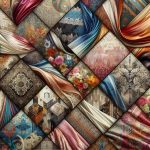When you think about textile innovation, William Morris might come to mind with his detailed and nature-inspired patterns that revolutionized the Arts and Crafts movement. But have you considered how Mariano Fortuny's blend of ancient techniques and modern technology influenced contemporary fashion? As you explore the bold colors of Zandra Rhodes and Kaffe Fassett, or the abstract designs of Vera Neumann, you'll notice a common thread of pushing boundaries. The Missoni family's iconic patterns and Iris Van Herpen's technological fusion show that textile design is a constantly evolving field. What drives these designers to continually break the mold?
Table of Contents
Key Takeaways
- William Morris led the textile revival with intricate nature-inspired patterns and a focus on craftsmanship over mass production.
- Mariano Fortuny's mastery in color theory and innovative fabric manipulation techniques influenced modern textile design.
- Zandra Rhodes is known for her bold, vibrant patterns and cross-cultural inspirations, redefining contemporary textile aesthetics.
- Kaffe Fassett encourages fearless use of color and intricate patterns, drawing inspiration from rich tapestries and mosaics.
- Iris Van Herpen integrates cutting-edge technology with craftsmanship, using innovative materials and techniques like 3D printing and laser cutting.
William Morris
How did William Morris revolutionize textile design in the 19th century?
By leading the textile revival through the Arts and Crafts movement, Morris established himself as a pioneer who valued craftsmanship and artistry over industrial mass production. He believed that everyday objects shouldn't only be functional but also aesthetically pleasing. His approach was a stark contrast to the prevailing trends of the time, which often favored cheaper, machine-made products.
Morris drew inspiration from nature, creating intricate patterns that mirrored the organic forms of plants, flowers, and animals. His designs featured meticulous detail and a harmonious blend of colors, capturing the essence of the natural world. By doing so, he brought a revitalizing authenticity and beauty to textile design that hadn't been seen before.
When you study Morris's work, you'll notice how his nature-inspired themes and intricate patterns set a new standard in textile design.
His commitment to high-quality materials and traditional techniques invigorated the textile industry and made handcrafted textiles desirable once again. Through his visionary contributions, Morris didn't just change textiles; he elevated them to an art form, ensuring their lasting impact on design history.
Mariano Fortuny
When exploring Mariano Fortuny's contributions to textile design, you'll find his early life deeply influenced his work.
His signature techniques, like pleating and innovative dye processes, set him apart.
Fortuny's legacy continues to impact modern fashion and fabric design, showcasing his enduring influence.
Early Life Influences
Mariano Fortuny's early exposure to art and culture profoundly shaped his innovative approach to textile design. Growing up in a family deeply entrenched in the arts, Fortuny's childhood experiences were rich with artistic influences. His father, a renowned painter, and his mother, an accomplished musician, provided a stimulating environment that nurtured his creative instincts.
Imagine being surrounded by masterpieces and melodies from a young age; it's no wonder Fortuny's artistic sensibilities were finely tuned.
In addition to his familial surroundings, Fortuny's early education played a critical role in his creative development. He received extensive training in diverse artistic disciplines, including painting, sculpture, and photography. This multidisciplinary education equipped him with a unique skill set that later translated into his textile innovations.
You can see how his mastery of different art forms laid the groundwork for his future endeavors.
Fortuny's travels across Europe further broadened his artistic horizons. Exposure to various cultures and their traditional crafts enriched his understanding of textiles. By combining these diverse influences, Fortuny developed a distinctive aesthetic that set him apart from his contemporaries.
His early life was a crucible of creativity, forging the visionary designer we celebrate today.
Signature Design Techniques
Building on his rich early experiences, Fortuny developed signature design techniques that revolutionized the world of textiles. His mastery of color theory and textile manipulation allowed him to create fabrics that were both visually stunning and tactilely unique. You can appreciate how he intricately blended dyes to achieve hues that seemed almost to glow. His deep understanding of color theory enabled him to craft combinations that were both harmonious and striking.
Fortuny's approach to pattern mixing was equally innovative. He didn't just settle for traditional designs; instead, he drew from a multitude of influences, from ancient Greek motifs to Renaissance patterns, seamlessly integrating them into his textiles. This kind of fabric experimentation set his work apart.
To understand Fortuny's revolutionary techniques, focus on these key elements:
- Color Theory: Mastery in blending dyes to achieve vibrant, harmonious hues.
- Textile Manipulation: Innovative methods for creating unique textures and finishes.
- Pattern Mixing: Integration of diverse historical and cultural motifs into cohesive designs.
Lasting Legacy Impact
How has Fortuny's pioneering work in textile design continued to influence modern fabric designers?
You're about to discover how his artistic vision and creative innovations have left an indelible mark on the fabric industry.
Fortuny's mastery of dyeing techniques and pleating methods set a new standard in the early 20th century.
His approach to textiles wasn't just about aesthetics; it was a holistic fusion of art, technology, and craftsmanship that transcended his era.
Today, Fortuny's global impact is evident in the work of contemporary designers who endeavor to blend tradition with innovation.
His techniques have spurred a design evolution, encouraging modern creators to explore the boundaries of fabric manipulation and dye application.
You can see Fortuny's enduring influence in the luxurious textures and intricate patterns that define high-end fashion and interior design.
Zandra Rhodes
You can't talk about bold design without mentioning Zandra Rhodes.
Her work stands out with vibrant colors and patterns inspired by various cultures.
You'll find her influence everywhere, from haute couture to everyday fashion.
Bold Design Aesthetic
Renowned for her vibrant color palettes and daring patterns, Zandra Rhodes has redefined what it means to have a bold design aesthetic in the world of fabric. Her work is a masterclass in blending modern interpretations with avant-garde creations, making her an icon for those who seek to push boundaries.
You can see her artistic expressions in every piece, reflecting contemporary influences that are both striking and imaginative.
To truly appreciate Rhodes' bold design aesthetic, consider these key elements:
- Color: She doesn't shy away from vivid hues and unexpected combinations, making her fabrics stand out in any context.
- Pattern: Her daring, often whimsical patterns challenge traditional norms, offering a fresh perspective on fabric design.
- Innovation: Rhodes consistently experiments with new techniques and materials, ensuring her work remains at the forefront of the industry.
When you explore Zandra Rhodes' collections, you're not just looking at fabric; you're witnessing a narrative of bold creativity and fearless innovation. Her ability to translate complex concepts into tangible, wearable art is unparalleled, making her a true pioneer in the domain of textile design.
Cultural Inspirations
Drawing from a rich fabric of global cultures, Zandra Rhodes infuses her designs with diverse influences that make each piece uniquely enchanting. As you explore her work, you'll notice how she seamlessly integrates global inspirations and traditional patterns, creating a vibrant fusion that transcends borders. Her ability to blend cross-cultural motifs and ethnic inspirations sets her apart in the world of textile design.
When you immerse yourself in Rhodes' collections, you'll see how she masterfully incorporates elements from African tribal art, Indian textiles, and Japanese kimonos. Each design tells a story, echoing the diverse cultural heritage that inspires her. Her use of bold, vibrant colors and intricate patterns is a tribute to her appreciation for global artistry.
Rhodes doesn't just replicate these traditional patterns; she reimagines them, giving them a fresh, contemporary twist. This ability to innovate while honoring cultural roots is what makes her work resonate deeply with those who seek originality and authenticity in fashion. By embracing and celebrating the beauty of various cultures, Zandra Rhodes not only creates stunning fabrics but also fosters a greater appreciation for the rich diversity of global artistic traditions.
Kaffe Fassett
Kaffe Fassett's vibrant and eclectic designs have revolutionized the textile industry, inspiring countless artists and quilters worldwide. His mastery lies in his fearless use of color and intricate patterns, transforming simple fabrics into works of art. You'll find his colorful patterns bursting with life and energy, making them perfect for anyone looking to add a bold statement to their projects.
Fassett's initial foray into the world of textiles started with knitting, where he drew knitting inspirations from the rich tapestries and intricate mosaics he encountered during his travels. His unique approach encouraged others to experiment and break free from traditional constraints.
When exploring his work, you'll notice three key elements that set his designs apart:
- Bold Color Choices: Fassett doesn't shy away from striking, unexpected color combinations, creating a visual feast for the eyes.
- Complex Patterns: His designs often feature intricate details that challenge and inspire even the most seasoned crafters.
- Global Inspirations: Fassett pulls from a diverse range of cultural motifs, bringing a worldly flair to his textiles.
Vera Neumann
Just as Kaffe Fassett's bold designs have made a significant impact, Vera Neumann's innovative approach to textile design has left an indelible mark on the industry. Her work stands out for its use of abstract patterns and vibrant colors, which transformed modern textiles and elevated everyday items into pieces of art. Vera, an artist at heart, drew her artistic inspirations from nature, which you can see in her distinctive motifs of flora and fauna.
Vera's fashion collaborations were groundbreaking. She partnered with major fashion houses, bringing her unique designs to a broader audience. Her scarves, in particular, became iconic, blending functionality with artistic flair. Neumann's ability to merge art and fashion so seamlessly earned her a dedicated following.
To better understand Vera Neumann's impact, consider the following:
| Aspect | Vera Neumann's Influence |
|---|---|
| Artistic Inspirations | Nature, flora and fauna |
| Design Style | Abstract patterns |
| Medium | Modern textiles |
| Key Products | Scarves, home décor items |
| Collaborations | Major fashion houses |
Alexander Girard
Alexander Girard's vibrant and whimsical designs have fundamentally transformed the world of textile arts. As a pivotal figure in the mid-century modern aesthetic, Girard brought a fresh, playful perspective to fabric design, making his work instantly recognizable.
You can't discuss colorful patterns without mentioning Girard, whose bold use of color and form set new standards in the industry. Girard's influence is far-reaching. His work did more than just decorate; it brought joy and a sense of wonder into everyday life.
Here's why his designs are so celebrated:
- Innovative Use of Color: Girard's mastery of hues created lively, dynamic textiles that remain timeless.
- Bold, Whimsical Patterns: His designs often featured abstract, almost childlike motifs that were both sophisticated and accessible.
- Cultural Integration: Girard drew inspiration from various cultures, blending traditional elements with contemporary forms.
Missoni Family
The Missoni family has revolutionized the textile industry with their iconic zigzag patterns and vibrant color palettes. Originating from Italy, the Missoni family has seamlessly woven their way into the annals of Italian fashion history. Their designs, easily recognizable and often imitated, have become synonymous with high-quality and innovative textiles.
You can see the brilliance of Missoni textiles in their signature patterns—bold, dynamic, and unapologetically colorful. These iconic patterns aren't just visually striking; they also embody the spirit and heritage of Italian craftsmanship.
The Missoni family's approach to design is both meticulous and imaginative, showcasing a mastery that combines tradition with a modern twist.
Iris Van Herpen
Iris Van Herpen stands at the forefront of textile innovation, fusing cutting-edge technology with exquisite craftsmanship to create ethereal, otherworldly designs. When you explore her work, you'll see that she doesn't just make clothes; she sculpts wearable art. Van Herpen's designs often draw inspiration from nature, science, and architecture, resulting in futuristic fashion that defies conventional boundaries.
She's known for using innovative materials that push the limits of what's possible in fashion. You'll find that her collections frequently incorporate 3D printing, laser cutting, and other pioneering techniques. This commitment to innovation has led to garments that seem almost alive, moving and transforming with every step.
To better understand her impact, consider these key attributes of Van Herpen's work:
- Innovative Materials: She employs materials like silicone, organza, and even magnets to create unique textures and forms.
- Technological Integration: Van Herpen's use of 3D printing and laser cutting techniques allows for unparalleled precision and complexity.
- Futuristic Fashion: Her designs look straight out of a sci-fi movie, offering a glimpse into the future of haute couture.
Stella McCartney
Stella McCartney revolutionizes the fashion industry by prioritizing sustainable and ethical practices in her textile designs. You'll marvel at her commitment to eco-friendly materials, avoiding leather and fur altogether. McCartney's dedication to sustainable fashion safeguards that every piece is not only stylish but also kind to the planet. Her innovative approach involves using organic cotton, recycled polyester, and regenerated cashmere, setting a high standard for others in the industry.
Stella McCartney also excels in celebrity collaborations, seamlessly blending star power with her ethical ethos. Collaborations with icons like Madonna, Kate Hudson, and Taylor Swift have brought her sustainable vision to a broader audience. These partnerships amplify her message, proving that luxury and sustainability can coexist beautifully.
Consider her impact through this concise overview:
| Aspect | Details | Impact |
|---|---|---|
| Sustainable Materials | Organic cotton, recycled polyester, regenerated cashmere | Reduces environmental footprint |
| Ethical Practices | No leather or fur | Promotes animal welfare |
| Celebrity Collaborations | Madonna, Kate Hudson, Taylor Swift | Elevates brand visibility and influence |
Frequently Asked Questions
How Do Fabric Designers Typically Source Their Materials?
You typically source your materials from trusted material suppliers and through global sourcing. Your artistic inspiration and creative process guide you in selecting the best fabrics to bring your innovative designs to life.
What Technologies Are Revolutionizing Fabric Design Today?
You're seeing a revolution in fabric design with technologies like digital printing and smart textiles. Digital printing allows for intricate, customizable patterns, while smart textiles integrate sensors and electronics, enhancing functionality and opening new creative possibilities.
How Does Sustainability Impact the Fabric Design Industry?
Did you know that 85% of textiles end up in landfills? By prioritizing eco-friendly materials and ethical manufacturing, you can embrace a circular economy, contributing substantially to waste reduction and a more sustainable fabric design industry.
What Are the Most Popular Fabric Trends Currently?
You want to know the most popular fabric trends right now? Sustainable fabrics and ethical sourcing lead the way. Digital printing and custom patterns are also huge, letting you create unique, eco-friendly designs that truly stand out.
How Can One Start a Career in Fabric Design?
To start a career in fabric design, enroll in design schools and secure internships. Focus on portfolio building and networking to showcase your skills and connect with industry professionals. These steps will set you on the path to mastery.
- How Does Ring Spun Cotton Affect Garment Fit and Shape Retention? - August 13, 2024
- What Are the Challenges in Producing Ring Spun Cotton? - August 13, 2024
- Is Ring Spun Cotton Suitable for Plus-Size Clothing? - August 13, 2024







